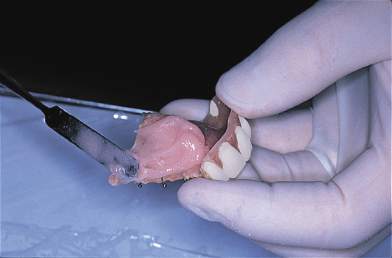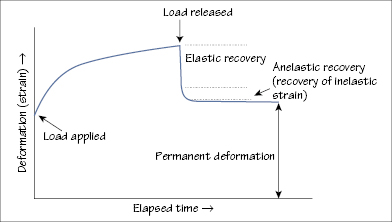23
Denture liners
Figure 23.1 Placement of PermaSoft within a denture. (Courtesy of Dentsply International.)

Figure 23.2 Schematic representation of shock-absorbing capability of silicone and polyphosphazene elastomeric resilient liners.

Figure 23.3 Elastic, anelastic, and permanent deformation of a viscoelastic gel under loading and after load release.

Figure 23.4 Schematic representation of the deformation of a tissue conditioner under rapid (dynamic) loading and slow (quasi-static) loading.

Hard denture relining with PMMA or light-cured materials improves fit or corrects occlusion problems whereas soft (or resilient) liners are used as cushioning materials placed on the intaglio surface, as noted in Chapter 20. Denture liners fall into two broad categories, resilient liners and tissue conditioners.
23.1 Resilient (soft) liners
Soft liners provide “shock-absorbing” (cushioning) by evenly distributing functional loads and avoiding local stress concentrations, thus helping manage traumatized oral mucosa, bony undercuts, bruxism, ridge atrophy, and congenital oral defects. The principal resilient liner materials are plasticized acrylics, vinyl polymers, and silicone and polyphosphazene elastomers. Figure 23.1 shows placement of a resilient liner within a denture.
23.1.1 Resilient liner materials—modified acrylic resins
Because of their free monomer content, conventional acrylics are contraindicated for direct placement on irritated mucosa, even when heavily plasticized. Acrylic-based resilient liners commonly combine poly(ethylmethacrylate) (PEMA) and methyl methacrylate monomer together with a plasticizer such as butyl phthalyl butyl glycolate (BPBG) or dibutyl phthalate (DBP).
PEMA has a Tg of 65°C, lowered by plasticizer addition, compared with 125°C Tg for PMMA, and their chemical />
Stay updated, free dental videos. Join our Telegram channel

VIDEdental - Online dental courses


